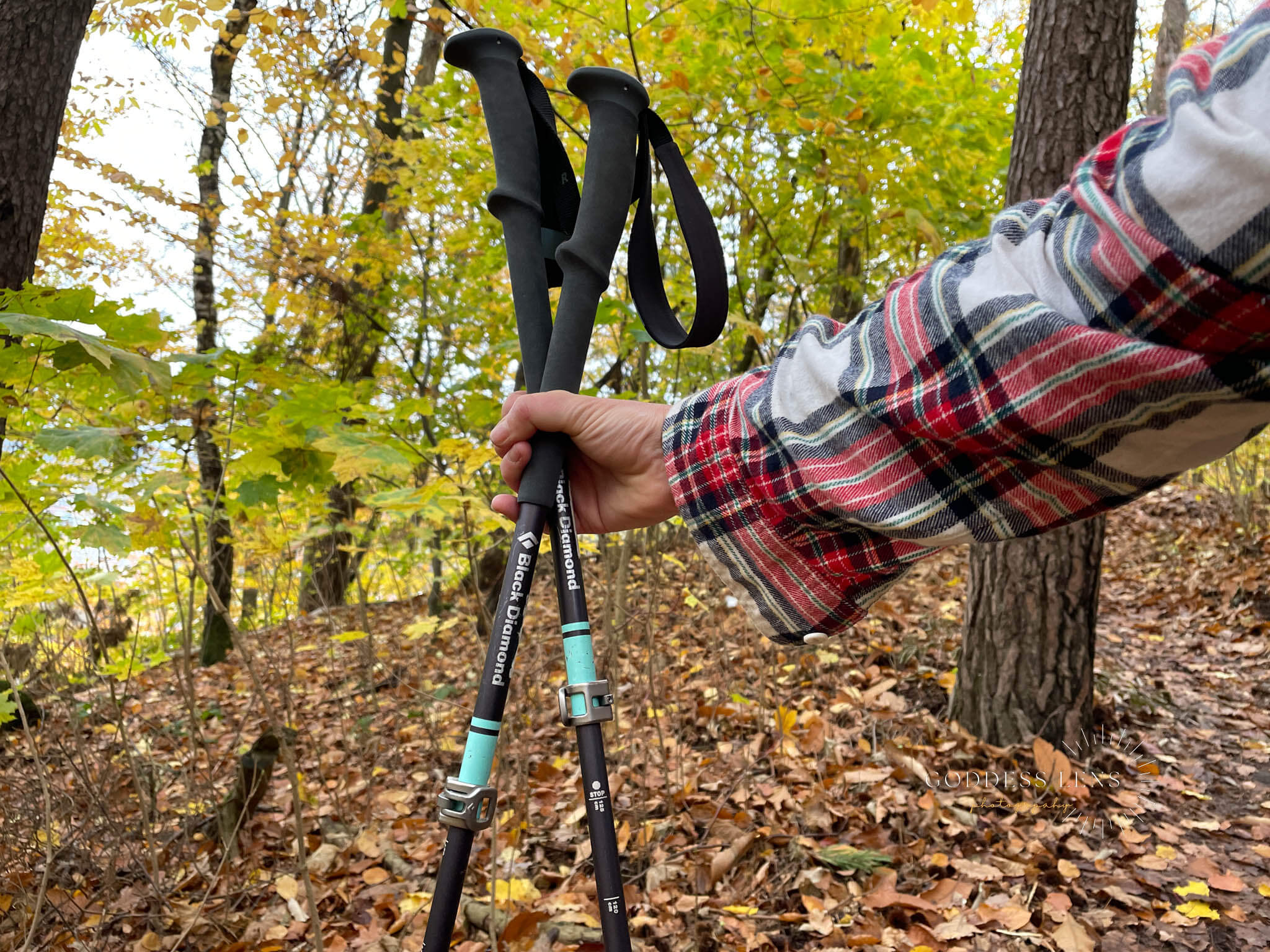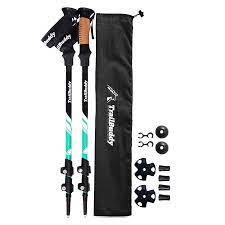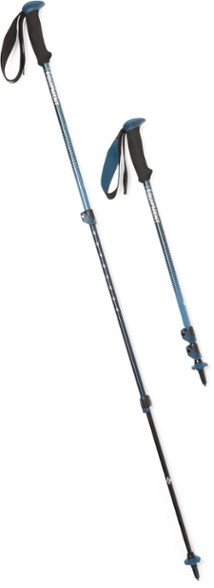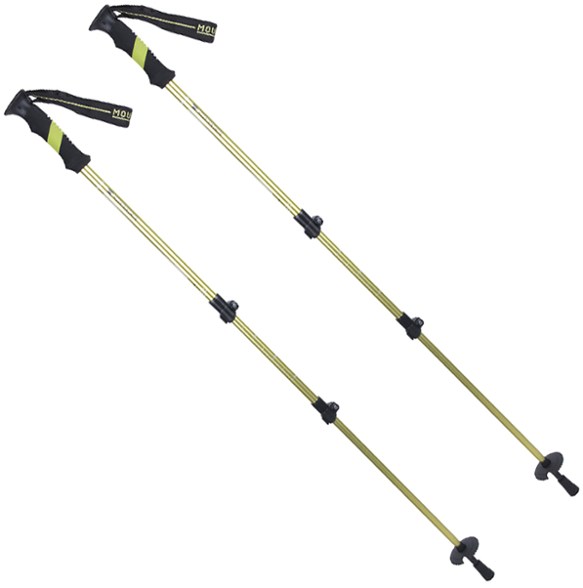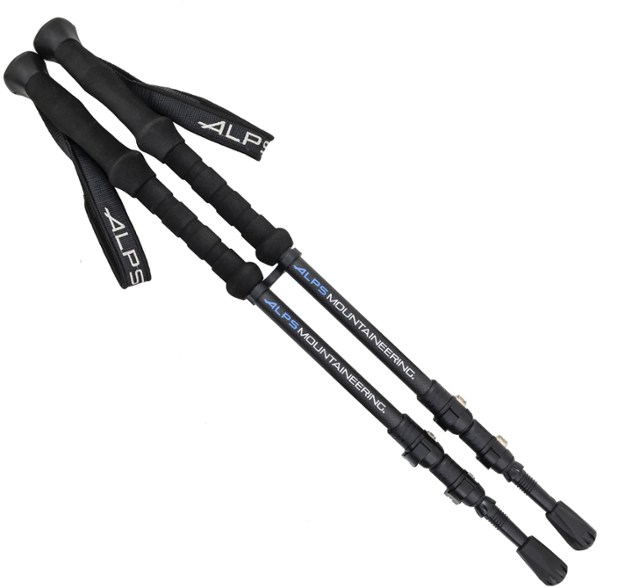Are you curious about how to use trekking poles the right way? I’ve been a physical therapist for 15+ years and can tell you that they serve a great purpose for people that want to do longer hikes, have some body or joint pain and it’s backed by science.
My husband makes fun of me for using my favorite Black Diamond trekking poles (aka: downhill knee pain reducers).
But what does science say about how to use trekking poles based on 40 years of peer reviewed research? Read on to learn about the pros and cons of using hiking poles or read my review of the best trekking poles on the market.
How to Use Trekking Poles Video
What are Trekking Poles and How to Use Trekking Poles Correctly?
Trekking poles, otherwise known as hiking sticks, hiking poles, or walking sticks offer:
❤️🔥Increased stamina.
🧊Better stability.
🥾Reduced demand on lower body joints & muscles like calves and toes.
🦺Decreased Risk of Falls and Injury.
🐻A weapon to fight bears!?! Just kidding. Don’t try to fight a bear with a trekking pole. Spray works much better.
✈️ BTW: Don’t take your trekking poles on a plane as carryon, they get confiscated as weapons.
TL;DR: Collapsible trekking poles benefit people that want more safety, to reduce lower body fatigue, fall and injury risk, and knee/hip/ankle joint pain when hiking, especially when wearing a weighted backpack.
However, they do increase cardiovascular load, meaning that you’ll probably get your heart rate moving faster and do more cardio on the same hike than without poles.
It’s the sweat – joint pain tradeoff.
Can you bring hiking sticks on a plane?
A question I get asked a lot is how to bring trekking poles on a plane. Read until the end where I share my best practices.
Also, I’ll share tips for seniors that may have mobility problems, neurological problems, osteoarthritis, plantar fasciitis, meniscus tears, cartilage damage or knee replacements and how trekking poles can improve quality of life.
How to Use Trekking Poles Properly For Hiking
These are beneficial for people going on longer hikes, over treacherous terrain or recovering after a surgery. They also increase cardiovascular demand, so it can boost your fitness if you learn how to use trekking poles.
It’s vital to estimate your hiking time correct
Using a Trekking Pole Properly
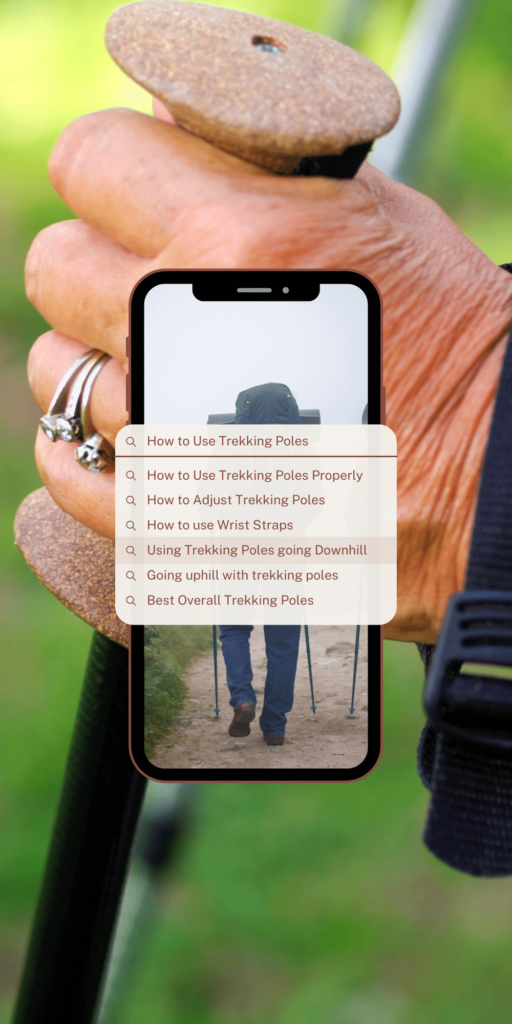
➡️ Trekking poles should feel like an extension of your arms & be lightweight.
➡️ If using one or two trekking poles, you should almost always move your opposite arm and leg together.
Going uphill : Shorten your poles by 5-10 cm
Going downhill: Lengthen your poles by 5-10 cm. Mind your tips – don’t stab fellow hikers.
Best Overall Trekking Poles: Black Diamond Trail Pro
Benefits for Seniors: Reduced risk of falls, improved stamina, less lower body joint pain
How to Use Trekking Poles
1. Adjusting the Length of Trekking Poles
How to Set Length of Hiking Pole
First you’ve got to figure out the locking mechanism of your adjustable poles. Whether it’s an external lock (quick-lock, flick-lock) or an internal lock (twist-lock), these locks connect each interlocking section of your poles.
Some poles collapse by folding and some collapse by telescoping into itself.
To determine the best length of trekking poles :
- Stand tall on a flat surface
- Place the tip of the trekking pole 4 inches to the outside of your pinkie toe
- Hold the handle and get your elbows to a 90 degree bend
- Adjust the length of the pole to this height.
- Uphill and Downhill this will change
Remember your numbers so you don’t have to fit them every time. I’m 5’6” and typically range between 110-117 cm, but everyone has different trunk and leg lengths and personal preference.
2. Gripping Your Poles – No Death Grip!
The handgrips on poles are usually made of cork, rubber or foam. For each of these types you should utilize the wrist strap so you don’t feel the need to have a “death grip” on your poles.
Hands are sensitive and for long hikes it’s not helpful to have a “death grip”.
Some poles provide a small notch to rest between your index and middle finger to help relax your grip.
#1 Tip for how to use walking poles: relax your grip in almost every circumstance to improve performance and comfort.
Using the Wrist Strap
Much like a ski pole, you’ll want to thread your hand through the strap from the top so that you don’t have to grip the pole hard and you can lift your arms up and the strap will keep the pole attached to your arm.
3. How to Use Trekking Pole Straps & Gloves
Many poles have adjustable straps that you simply pull a tab in order to get them to a place that is comfortable but not too tight around your entire wrist.
Some poles have a specialized glove strap that provides a special place for your thumb and it feels tighter. Be careful though with prolonged hikes with these types of straps as it can cause a nerve sensitivity in your wrist. There are many nerves running through your wrist and outside thumb area and if you press on it for prolonged period it can get irritated.
The thumb type straps also keep your hands very warm and sweaty, so that depends on your preference. If your hands are always cold you may like it, but if you’re like me and walking the Camino de Santiago it’s not a benefit.
4. How to Use Trekking Pole Tips
The standard trekking pole tip is a dull metal tip. This works great on softer terrains like mud, dirt and grass.
When to Use Trekking Pole Tips – Rubber
If you will be hiking or walking over rocky terrain or roads with pavement, asphalt or hard dirt you’ll want to purchase rubber tips for trekking poles.
Around $10, they simply slide over your metal tip and provide a softer and quieter landing for your trekking poles.
➡️ These are my favorite tip protectors: Buy Here ➡️ Leki Rubber Accessories.
How to Use Trekking Pole Loops on Backpack
How to attach trekking pole to backpack : Collapse your poles as much as possible and attach them to the router side of your pack. Most quality bags come with a small loop on the bottom to place the tips and a small stretchy band to wrap around the handles.
How to Carry Trekking Pole in Flight
If you are going on a plane and want to bring your trekking poles you’ll first want to check with the airline to see if they allow them as carryon baggage. Some airlines consider the metal tips a weapon.
I’ve gotten by by putting rubber tips on my trekking poles on occasion. Sometimes it doesn’t matter even if i have rubber tips and they force me to check a bag with my collapsible poles inside the checked bag.
5. How to Choose Walking Poles
Easily Available Popular Trekking Poles Comparison Chart of Trekking Poles
Cascade Mountain Tech Trekking Poles Blue Cork
- Aircraft-grade 7075 aluminum,
- 10.6 -ounce trekking pole
- Quick Lock Mechanism
- Easily adjust your trekking poles from 44”- 54”
- Cork Grip with Extended EVA Down Grip
- Folding them down to 16.75"
Best for Knees : Black Diamond Women's Trail Pro
With hikes in the steep mountains, these are a lifesaver. It still hurts on steep declines, but far, far less.
- Shock absorption technology
- Author is probably biased - I LOVE these!!!
Absolute Cheapest : Trail Buddy Trekking Poles
Great starter trekking poles for people unsure if they want to utilize them on hikes.
- Super cheap trekking poles
- Comes with rubber tips and baskets.
- Come with padded straps, cork grip and external locks.
Best for All Season : BD Trail Back Trekking Poles
Perfect for those people that want to keep their outdoor adventures going into winter with snowshoeing, skitouring or even just safely walking to the mailbox on icy roads.
- The baskets can be changed out for snowbaskets.
Popular REI Trekking Poles : Mountainsmith Roamer
Super value trekking poles. They come with powder ski baskets and trekking baskets and rubber tips so you don't have to buy them separately.
- Has OLS - Outer lock system to make adjustments easy and quick.
- Shock absorption
Best Warranty : Komperdell Carbon
Best priced carbon fiber trekking poles and with a 3 year, no questions asked full repair service they are an excellent value for hikers going long distances.
- 3 year warranty no questions asked
- Built in Austria for serious hikers
- Most expensive
Best Budget Lekis : Trekking Poles Legacy Lite
Best for people that want a sturdy, yet lightweight trekking pole with an exceptionally comfortable grip.
- Cork grip and with ergonomically designed grip to alleviate wrist pain on prolonged hikes.
Best for Photographers : Camera Mount Hiker Power Lock
This is a hiking staff, so great for those that prefer to carry only one pole. The globe shaped top also allows more pressure to go through shaft.
- Great for people creating video content on their hikes
- Only one pole
Best Ultralight Trekking Poles : Alps Mountaineering Momentum
Perfect for people who want to go the distance as these are the lightest budget trekking poles on market.
- Comes with powder ski baskets and trekking baskets so you don't have to buy them separately.
Trekking Poles Review : Collapsible Trekking Poles
What are the features of good hiking poles? Every size does not fit all. One has to keep various factors in mind including durability, weather conditions, weight etc when considering how to use trekking poles.
- Collapsible vs non collapsible-
- Material- Usually the hiking poles are made of aluminum or carbon fiber. Both are good but each offers different benefits. Aluminum poles are cheaper, while carbon fiber poles are typically lighter.
- Pultruded vs rolled shaft carbon fiber processing
- Hand grips- Usually made of cork, rubber and foam. Cork is all weather, though rubber is good for winters as it insulates the hand whereas foam is excellent for summers as it absorbs sweat.
- Warranty length
- Weight
- Twist lock mechanism
- Tips
Leki Trekking Poles and Black Diamond Trail Trekking Poles have the best reviews.
6. Reduce Pain – How to Use Walking Poles to Reduce Pain
Walking poles/sticks How to Use to Reduce Pain
If you’ve got wrist pain, trekking poles are unlikely to help. However, if you’ve got issues with foot, ankle, knee or hip pain, then trekking poles are made for you to have more tolerance to the activity of hiking or walking. How to use trekking poles for pain is not much different than without.
Ways to Reduce Pain
- Don’t get injured by falling – Hiking poles help improve your balance
- Gradually increase your time, distance and difficulty of hiking slowly
- Add a lower body strength training program
- Offload the painful leg with the opposite arm and trekking pole.
- Take breaks before you think you need one. Pacing.
How to Use a Walking Sticks Efficiently
The most important thing when learning how to use trekking poles is the move the opposite arm and leg together. The purpose of the trekking pole is to offload the limb that hurts, but humans move with a “reciprocal gait pattern”. That means when our left leg goes forward, the right arm is swinging forward at the same time.
How to walk with walking sticks?
Do not be a pegleg pirate leaning into the left trekking pole when stepping down on the left leg. It takes a lot of extra energy and is not efficient.
Walking with poles also helps to get into a breathing rhythm with your steps.
Some people like to breath in when moving the left leg forward and out with the right. Or some version that fits your conditioning and the terrain.
How to use trekking poles and breath?
Coordinating the breath with movement has a lot of historical benefits with martial arts practices, running and marksmanship. Your core muscles are involved with breath and connect your upper and lower body muscles while hiking.
How to Use Trekking Poles Going Downhill
How do you use a trekking pole correctly going downhill? The correct height for walking poles varies based upon terrain.
If you have any balance or stability issues, simply slow down your pace and zigzag down the hill in effect making the hill less steep by going across the grade.
Going downhill you should lengthen the pole. If it is adjustable, add an extra 5-10 cm to the pole.
If you don’t have an adjustable pole then you can grab it by the uppermost part of the handle vs mid-shaft.
Second, always keep the pole between you and where you would fall. That means your poles are going to be more in front of you when going downhill than if you were on a flat surface or going uphill.
How to Use Trekking Poles Properly Going Uphill
Trekking Poles How to Use Uphill
Going uphill you should shorten your poles by 5-10 cm.
Your elbows will bend more and you should think of pumping your arms higher and in front of your chest. The pole tips should land near your feet or slightly behind and not in front of your body.
Winter and Skiing : How to Use Trekking Poles for Skiing
Can I Use Trekking Pole for Skiing?
Yes! How to use trekking poles for skiing depends on the model that you purchase. Most higher end poles are durable enough for skiing.
Using Trekking Pole for Skiing
You’ll need to purchase ski snow baskets (also known as trekking pole baskets) to attach to the end of your trekking poles. There are different versions of snow baskets depending upon the type of snow you will encounter but they generally cost around $10.
Micropikes
If you’re going to be walking or hiking in winter on slippery surfaces, a pair of micropsikes can also be very helpful. They slide on over your existing shoe with little spikes to give you improved winter traction.
7. How to Use Walking Sticks for Seniors
Whenever I mention I’m a physical therapist, people always ask me what the best exercise is.
In reality and the research the answer is always the same: walking.
Don’t get me wrong, I love fancy exercises.
Walking is something we often take for granted. But it’s effective, low-impact, costs very little and has mood enhancing benefits.
For many reasons, many of us stop walking. One of the main reasons being fear.
Fear of falling.
This is my absolute favorite use for trekking poles and why I teach people all the time how to use trekking poles.
They offer balance support and look cool at the same time. Nobody wants to carry around a cane, but a cool, carbon fiber trekking pole? Yes please!
How to Use Walking Sticks ⭐️
How to use a hiking stick isn’t complicated. Staying active and socially connected is the cornerstone to quality of life and reducing morbidity and mortality. If you feel more comfortable using walking sticks when you’re outdoors or going over uneven surfaces embrace it!
Aim to purchase and learn how to use trekking poles that are durable, collapsible and lightweight that you’ll cherish.
How to Use Walking Sticks for Balance: Walking Poles Advice
Reducing your risk for falls makes walking sticks a great purchase. The extra 2 points of support will reduce your risk of falls as you can catch yourself on small slips and trips. This doesn’t completely take away all risk, so please consider adequate rest breaks, pacing, and a gradual increase in the time, distance and difficulty of your walking and hiking.
How to Use Walking Sticks for Exercise
Using walking sticks for exercise is a simple and easy way to ensure safety on outdoor walks. To get more of a cardiovascular benefit use 2 trekking poles during your hikes or walks. They will naturally get your arms swinging to increase your exercise.
Research has shown even more benefit to seniors when they engage in group outdoor exercise. Consider joining a local nordic walking group that not only teaches how to use trekking poles but has a social aspect to improve your exercise even more.
How to Use a Single Walking Stick: Walking Poles How to Use
If you want to use one walking stick make sure that you switch hands every so often to balance out the muscular strain. If you have one leg with more chronic pain, use the stick primarily with the opposite arm to offload the weak or painful limb. How to use a single walking pole
How to Use a Single Hiking Pole for Neuro Problems
If you’ve got neurological problems like CVA or MS, it’s especially helpful to use a single hiking pole much in the same way you would use a straight cane or other assistive device. And it looks way cooler. ;-).
I would recommend getting the “thumb” style grip so your unaffected hand is less strained to hold onto the hiking pole. As always, consult your physical therapist as this is not medical advice on how to use a single walking pole.
Using walking poles is a balance between avoiding falls and fear avoidance behaviors, so any cheap trick (like learning how to use trekking poles) that helps empower your active lifestyle is a worthy investment.
The Best Hiking Pole for Seniors is the one they will use. So jazz it up and make it an accessory for style and life.
Overall Best Hiking Poles – Black Diamond Trail Trekking Poles
Black Diamond Women’s Trail Pro Trekking Poles
What do hikers think?
I picked up these poles after my husky crashed into my left knee resulting in a full thickness cartilage tear on the backside of my kneecap. With hikes in the steep Alps, they are a lifesaver. It still hurts on steep declines, but far, far less.
Type: Telescoping with twist lock, Aluminum shaft
Grip: Eva foam grip
✅ Pros: Flicklock Pro adjustability, Shock control technology to dampen forces and make downhills much more comfortable, very lightweight
▶️ Size: 23 inches collapsed, Useable length 37-49 inches. Weight per Pair: 1.93oz
🛑 Cons: More expensive, but ideal for people who only want to buy once
⭐️ Click here to Check Price Amazon or Check on Black Diamond
MORE HIKING RESOURCES
Get more physical therapist expert hiking tips here 👎🏻
- How to Use a Weighted Vest for Hiking Training
- Enjoy Hiking as a Hobby
- Another great idea is hiking in a dress!
- 🥾 Best Hut to Hut Hikes in Europe
- 🏰 Directory of Hiking Resources to Make Your Next Hike Comfortable
FAQ Trekking Poles
What is the best length for hiking poles?
The decider is your height and limb length. Elbows should form a right angle with the pole as you walk. That way you get the best support and most efficient gait pattern.
Is hiking with poles a better workout?
Hiking is an excellent exercise due to it’s low impact nature and being in Nature. Both have science-backed evidence to support the mind-body benefits and hiking poles will naturally increase the cardiovascular demand as compared to hiking without them. You’ll get your heartrate up higher so it’s a better workout.
Why do hikers use these poles?
To reduce fatigue on the lower body like knees ankles and hips. They also provide balance and stability on uneven surfaces.
Do inexpensive poles break easily?
Not necessarily, but I’ve found poles under $30 to be no better than a stick. I had a pair of Viking poles break on the first day of a 5 day backpacking trip and it was a real bummer.
Is it better to hike with one pole or two?
This is completely up to personal preference and goals of the hike. Do you want to move faster? Then use 2. Do you want to stop and take 2000 photos, take one.
Are Hiking Poles Worth It?
Hiking poles are worth it, especially for those with problems with their knees or are undertaking a long distance hike with a backpack.
I hope you enjoyed this article on how to use trekking poles. Keep on moving!

Author profile: Morgan Fielder is a Doctor of Physical Therapy and passionate hiker who believes in exploring the world on foot with good food. Follow her journey as she shares science-based hiking tips and advocates for sustainable tourism.


